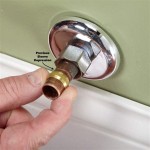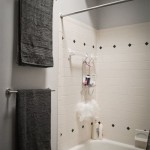How to Plumbing a New Bathroom Sink Drain Pipe
Installing a new bathroom sink drain pipe is a relatively straightforward plumbing project that can be tackled by homeowners with basic plumbing skills. This article will provide a comprehensive guide, step-by-step, on how to install a new bathroom sink drain pipe, equipping you with the knowledge to complete this task efficiently and safely. Before you begin, gather all the necessary tools and materials, ensuring you have a clear understanding of the process and safety precautions.
Understanding the Drain Pipe Components
A bathroom sink drain pipe typically consists of several essential components that work together to effectively drain water away from the sink. The main components include:
-
Drain Strainer:
Located at the bottom of the sink, the drain strainer captures hair and debris, preventing them from clogging the pipes. -
Tailpiece:
This short, threaded pipe connects the drain strainer to the P-trap. -
P-trap:
A U-shaped pipe that holds a small amount of water, preventing sewer gases from entering the home. It is called the "P-trap" due to its distinctive shape. -
Drain Pipe:
This pipe connects the P-trap to the main drain line, typically in a bathroom wall or under the floor.
Understanding the function of each component allows you to troubleshoot potential problems and ensure a smooth installation process.
Steps for Installing a New Bathroom Sink Drain Pipe
Now, let's delve into the step-by-step process of installing a new bathroom sink drain pipe.
1. Preparation and Disconnection
Begin by turning off the water supply to the sink and draining any remaining water from the sink. You may need to use a bucket to catch the water. Next, disconnect the existing drain pipe from the P-trap, carefully removing the nuts connecting the two components.
2. Installing the P-trap
Ensure the P-trap you are installing is compatible with your sink drain. Connect the P-trap to the drain tailpiece using a washer and nut, ensuring a tight seal. Next, connect the drain pipe to the other end of the P-trap using another washer and nut. Make sure to tighten the nuts securely, but avoid overtightening, which could damage the components.
3. Securing the Drain Pipe
Once the P-trap is installed, connect the end of the drain pipe to the main drain line. Use pipe joint compound (plumber's putty) to ensure a water-tight seal. The drain pipe should be secured to the wall or floor using pipe straps or clips for stability.
4. Connecting the Drain Strainer
Attach the drain strainer to the end of the tailpiece, ensuring it is properly seated. Use a wrench to tighten the nut on the strainer, ensuring a secure fit.
5. Testing and Finishing Touches
Before turning the water back on, inspect all connections for leaks. Once satisfied, turn the water supply on and carefully check for any leaks at the joints. If you find leaks, tighten the connections or reapply plumber's putty. After ensuring there are no leaks, you can install the sink and faucet onto the sink countertop.
Key Considerations
Here are some additional factors to consider when installing a new bathroom sink drain pipe:
1. Material Selection
Bathroom sink drain pipes are typically made of PVC (polyvinyl chloride) or ABS (acrylonitrile butadiene styrene) plastic. Both materials offer durability and corrosion resistance.
2. Proper Slope
The drain pipe should have a slight downward slope (typically 1/4 inch per foot) to ensure that water flows smoothly towards the main drain line. This slope prevents clogs and ensures proper drainage.
3. Vent Pipe Installation
In some cases, a vent pipe may be required to prevent siphoning action in the P-trap. If you are unsure whether a vent pipe is necessary, consult a professional plumber.
4. Safety Precautions
Always wear safety glasses and gloves when working with plumbing tools and materials. Ensure proper ventilation and avoid contact with hazardous substances. If you are unsure about any aspect of the installation process, seek the advice of a qualified plumber.
By carefully following the steps outlined in this guide, you can successfully install a new bathroom sink drain pipe. Remember to prioritize safety, double-check all connections, and contact a professional plumber for any complex or challenging aspects of the installation.

How To Plumb A Bathroom With Multiple Plumbing Diagrams Hammerpedia

How To Connect A Bathroom Sink Drain
How To Install Bathroom Sink Drain Queen Bee Of Honey Dos

How To Easily Connect The Plumbing For A New Bathroom Sink Hometips

Bathroom Sink Plumbing Installation

How To Plumb A Drain Sink Pipes

Bathroom Sink Plumbing Installation Diy Montreal

Bathroom Sink Plumbing

How To Install A P Trap Oatey

How To Replace And Install A Bathroom Sink
Related Posts







